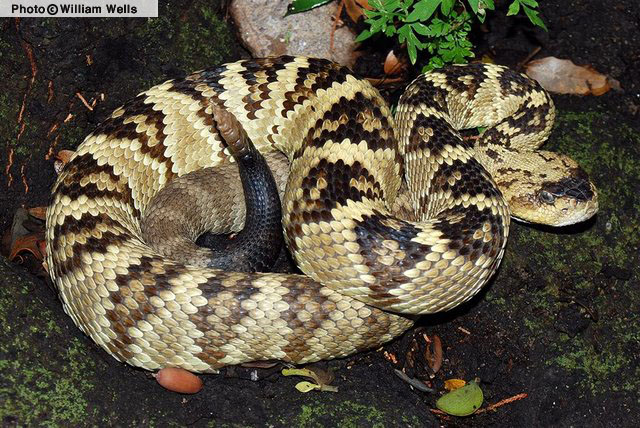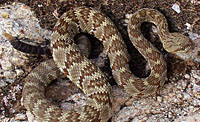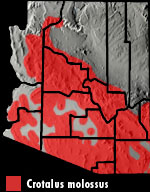Online Field Guide to The Reptiles and Amphibians of Arizona



Arizona
 Yuma Co., AZ |
| BLACK-TAILED RATTLESNAKE Crotalus molossus |
Venomous
|
|
DESCRIPTION: A large (up to 1,219 mm or 48″ in total length excluding rattle), brown, gray, yellow-brown, or golden yellow rattlesnake with a series of large, black or brown, blotches on the back (dorsal blotches). The blotches appear jagged-edged because each of this snakes dorsal scales is usually but a single color. A few light patches mark the interior of each dorsal blotch. The blotches are hexagonal with thin “straps” trailing down the sides to the belly. On the posterior part of the body the blotches become narrow, muted crossbands. The tail is black, sometimes with muted, dark, gray-brown rings. The top of the snout is usually black or dark brown. The pupils are vertically elliptical and the dorsal scales are keeled. The neck is slender and the head is broad and triangular. On the end of the tail is a rattle composed of a series of loosely interlocking keratinous sections. A new section is added each time the snake sheds its skin. Its uniformly dark tail distinguishes this snake from the Mohave Rattlesnake and Western Diamond-backed Rattlesnake. HABITAT: It is found in a wide variety of biotic communities ranging from Sonoran Desertscrub to the lower reaches of Petran Subalpine Conifer Forest. It seems to be most abundant in the woodlands. It is almost always found above the flats in hilly or mountainous terrain. BEHAVIOR: It can be active at any time of day or night when conditions are favorable. It is primarily diurnal and crepuscular in spring and fall and becomes crepuscular and nocturnal during the hot summer months. This ground-dweller is often quick to rattle at the first hint of danger and it often gives up its presence in this way. Like the other “pit-vipers” (members of the subfamily Crotalinae) this snake uses heat sensing pits (one on each side of the face between the eye and nostril) to detect warm-blooded predators and prey. DIET: Venom injected through long, hollow, retractable fangs is used to kill and begin digesting its prey. It feeds on mice, rats, rabbits, other small mammals, birds, and lizards. REPRODUCTION: Mating takes place in summer and up to 16 young are born in summer. REMARKS: This rattlesnake is capable of delivering large amounts of potent venom. If encountered it should be left alone. A large percentage of envenomations occur when a snake is handled or abused. By Thomas C. Brennan Bartlett. 2000. Snakes of North America: Western Brennan, T. C., and A. T. Holycross. 2006. A Field Guide to Amphibians and Reptiles in Arizona. Arizona Game and Fish Department. Phoenix, AZ Brennan, T. C., and A. T. Holycross. 2004 Crotalus oreganus concolor. Geographic Distribution. Herpetological Review 35(2). Fowlie. 1965. The Snakes of Arizona. Azul Quinta Press, Fallbrook, California Lowe, Schwalbe, Johnson. 1986. The Venomous Reptiles of Arizona. Nongame Branch Stebbins. 1985. Western Reptiles and Amphibians. Houghton Mifflin. New York, |
|
Visit Partners in Amphibian and Reptile Conservation:


HOME
Copyright © 2023, Arizona Game and Fish Department. All rights reserved.
If you make use of the textual contents of this site in reports, publications, etc. please cite and credit the author(s) and photographer(s). All photos on this website are copyrighted. However, those found in the species account section may be used for any noncommercial scientific, educational, or conservation purposes provided that photographs are not altered and continue to bear the copyright symbol and name of the photographer. Please contact the photographer regarding commercial use of copyrighted photographs.











